| A | B |
|---|
| An organism that harnesses light energy to drive the synthesis of organic compounds from carbon dioxide is called a(n) _____. | photoautotroph p565 |
| A short, hairlike prokaryotic appendage that functions in adherence to the substrate or to other cells is called _____. | fimbria (plural - fimbriae) p558,  |
| An organism that needs only carbon dioxide as a carbon source but obtains energy by oxidizing inorganic substances is called a(n) _____. | chemoautotroph p565 |
| An organism that must consume organic molecules for both energy and carbon is called a(n) _____. | chemoheterotroph (humans are chemoheterotrophs) p565 |
| Organisms that must consume organic molecules for a source of carbon to build other organic molecules are called _____. | heterotrophs (The two types of heterotrophs are photoheterotrophs and chemoheterotrophs.) p564 |
| Any organism that can use some form of carbon dioxide as its carbon source is called a(n) _____. | autotroph (The two types of autotrophs are photoautotrophs and chemoautotrophs) p565 |
| A microorganism that lives in an unusually saline ("salty") environment, such as the Great Salt Lake, or the Dead Sea, is called a(n) _____. | extreme halophile p567 |
| Gram- _____ bacteria are often times more toxic than gram- ____ bacteria. | negative, positive p557,  |
| The assimilation of atmospheric nitrogen by certain prokaryotes into nitrogenous compounds that can be directly used by plants is called ____. | nitrogen fixation p564 |
| The larger participant in a symbiotic relationship, serving as home and feeding ground to the symbiont is called the ____. | host p570 |
| A microorganism that lives in an extreme environment is called a(n) ____. | extremophile (Extremophiles include the extreme halophiles and the extreme thermophiles. Extremophiles are associated with the Archaea domain) p567 |
| An organism that requires oxygen for cellular respiration and cannot live without it is called a(n) _____. | obligate aerobe p564 |
| A component of the outer membrane of certain gram-negative bacteria responsible for generalized symptoms of fever and ache is called a(n) ____. | endotoxin (Food poisoning caused by bacteria from the genus Salmonella is caused by an endotoxin) p572 |
| An organism that uses light to generate ATP but must obtain carbon in organic form (instead of CO2) is called a(n) _____. | photoheterotroph p565 |
| A staining method that distinguishes between two different kinds of bacterial cell walls is called the ____. | gram stain p557,  |
| The sticky layer that surrounds the cell walls of some bacteria, protecting the cell surface and sometimes helping to glue the cell to surfaces is called the ____. | capsule (Its called a capsule if it is dense and well defined. If it is less well organized, it is called a slime layer) p558,  |
| A thick-coated, resistant cell produced within a bacterial cell exposed to harsh conditions is called a(n) ____. | endospore p560,  |
| Movement toward or away from a stimulus is called _____. | taxis p558 |
| A small ring of DNA that carries accessory genes separate from those of a bacterial chromosome is called a(n) ____. | plasmid (plasmids are also found in some eukaryotes, such as yeast) p560, 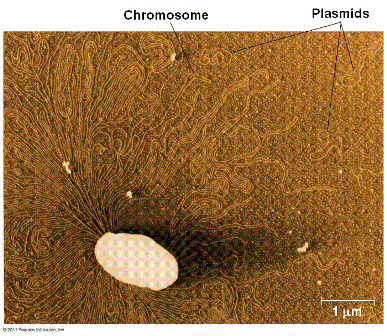 |
| An ecological relationship between organisms of two different species that live together in direct contact is called _____. | symbiosis p570 |
| An organism that absorbs nutrients from the body fluids of living hosts would be classified as a(n) ____. | parasite p570 |
| The use of living organisms to detoxify and restore polluted and degraded ecosystems is called ____. | bioremediation p573 |
| A toxic protein that is secreted by a bacterial cell and that produces specific symptoms even in the absence of the bacterium is called a(n) _____. | exotoxin p572 |
| A long, hairlike prokaryotic appendage that functions in adherence or in the transfer of DNA during conjugation is called a(n) ____. | pilus (plural - pili. When involved with the process of conjugation, the pili are often times called sex pili) p558, 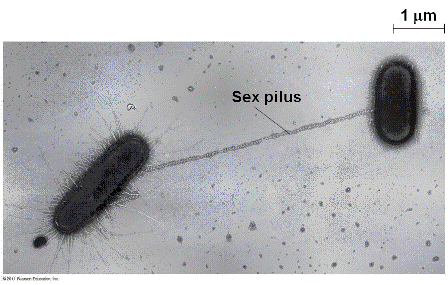 |
| A bacterium that absorbs nutrients from nonliving organic materials such as corpses, fallen plant material, and the wastes of living organisms and converts them into inorganic forms would be classified as a(n) ____. | decomposer p570 |
| A symbiotic relationship in which the symbiont benefits at the expense of the host is called ____. | parasitism p570 |
| A symbiotic relationship in which both participants benefit is called ____. | mutualism p570 |
| The smaller participant in a symbiotic relationship, living in or on the host is called the ____. | symbiont p570 |
| A type of polymer in bacterial cell walls consisting of modified sugars cross-linked by short polypeptides is called a(n) ____. | peptidoglycan (Archaean prokaryotes do not contain peptidoglycan) p557,  |
| A microorganism that obtains energy by using carbon dioxide to oxidize hydrogen, producing methane as a waste product is called a(n) ____. | methanogen (Methanogens can be found in anoxic swamps and the guts of some herbivores, like cattle and termites. They are also used to treat sewage at treatment plants) p567 |
| An organism that makes ATP by aerobic respiration if oxygen is present, but that switches to fermentation or anaerobic respiration under anaerobic conditions, is called a(n) ____. | facultative anaerobe p564 |
| The region in a prokaryotic cell consisting of a concentrated mass of DNA is called the _______. | nucleoid region p560,  |
| An organism that cannot use oxygen and is in fact poisoned by it is called a(n) _____. | obligate anaerobe p564 |
| A surface-coating colony of prokaryotes that engage in metabolic cooperation is called a(n) ____. | biofilm p565 |
| A symbiotic relationship in which the symbiont benefits but the host is neither helped nor harmed is called _____. | commensalism p570 |
Prokaryotic cells lack _______, 
| a nucleus and other membrane-bound organelles pp559&560 |
| Cells that have a nucleus and membrane bound organelles are called ____ cells. | eukaryotic G-13, 
|
| What are three different shapes that bacteria can be (Give name and description)? | spheres (cocci), rod-shaped (bacilli), spiral p557, 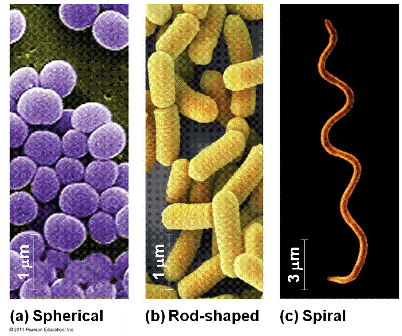 |
| Bacteria that stain purple are known as _______ . | gram-positive bacteria p557,  |
| Bacteria that don't stain purple are known as ______. | gram-negative bacteria p557,  |
| Mutualism, parasitism and commensalism are all types of ____. | symbiosis p570, 
|
| Some bacteria have a whip-like tail called a ____. | flagellum p558, 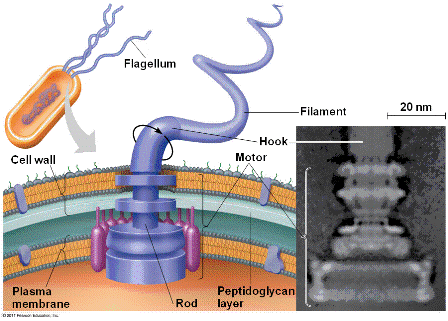 , , 
|
| The structure just outside the cell membrane of a bacterium is called the ___. | cell wall p557,  |
| Which gas in the atmosphere do some bacteria capture and turn into fertilizer that plants can use? | nitrogen p564 |
| Medicines that kill bacteria as well as other living microorganisms are known as ____. | antibiotics p564, 
|
| What's a major difference between the cell walls of the bacteria in domain Archaea and those in the domain Bacteria? | Archaean cell walls lack peptidoglycan. p557 |
| Compare gram-positive and gram negative bacteria for the amount of peptidoglycan in their cell walls and their structural complexity. | Gram-positive bacteria have more peptidoglycan in their cell walls and their cell walls are structurally simpler compared to gram-negative bacteria. p557,  |
| Fimbriae and pili are both hairlike structures that help some bacteria adhere to surfaces. Fimbriae are usually ____ numerous and ____ than pili. | more, shorter (pili are often times used to transfer DNA from one bacterium to another) p558, 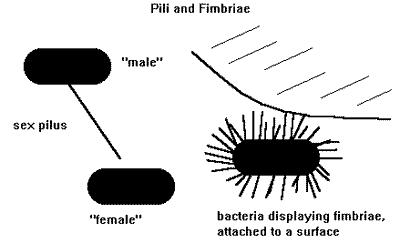 |
| Specialized pili, called sex pili, link prokaryotes during ______, a process in which one cell transfers DNA to another cell. | conjugation p562,  |
| What are two major differences between the flagella of prokaryotes and the flagella of eukaryotes? | Eukaryotic flagella are about 10 times thicker and are covered by an extension of the cell membrane (They are also different in their molecular composition and mechanism of propulsion, and are therefore thought to be analogous to eukaryotic flagella, not homologous) p558,  |
| A single cell cannot carry out ______ and photosynthesis at the same time. | nitrogen fixation p565 |
| A single cell cannot carry out ______ and nitrogen fixation at the same time. | photosynthesis p565 |
| What is the name of the bacteria that live within the root nodules of legumes (plants of the pea/bean family) and fix nitrogen? | Rhizobium p568 |
| What is the scientific name of the bacteria that reside in the intestines of mammals, including humans? | E. coli (Escherichia coli) p572 |
| What do you call the photosynthetic oxygen producing bacteria? | Cyanobacteria (a.k.a. - Blue-green bacteria) |
| ______ is the movement of an organism toward or away from chemicals, such as oxygen, nutrients, or pheromones). | chemotaxis p558 |
| Evidence indicates that bacterial flagella originated as simpler structures that had functions unrelated to the function of flagella (motility). This is an example of a(n) ______. | exaptation p559 |
| Prokaryotic cells lack membrane bound organelles, however, some do have specialized membranes that perform metabolic functions, similar to the cristae of mitochondria or the thylakoids of chloroplasts. Why are these membranes not considered to be organelles? | They are usually infoldings of the plasma membrane p559, 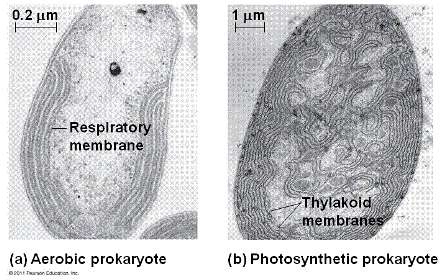 |
What is this a picture of?, 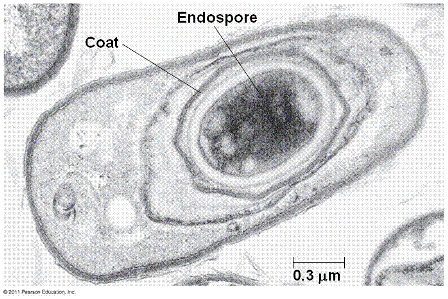 | Bacterial endospore (Endospores are dormant phases of bacterial cells that can for centuries and extreme conditions, like boiling water) p560,  |
| Prokaryotes reproduce asexually in a process called _____. | binary fission p560,  |
| Under ideal conditions, some prokaryotes (including E. coli) can divide every ______. | 20 minutes (At this rate, 1 bacterium could become a million in less than 7 hours. At this rate, 1 bacterium could give rise to enough bacteria to outweigh the Earth in only two days!) p560 |
| The uptake of foreign DNA by prokaryotes from their surroundings is called ____. | transformation p562 |
| In the process of _____, DNA can be transferred from one prokaryote to another by a virus called a bacteriophage. | transduction p562, 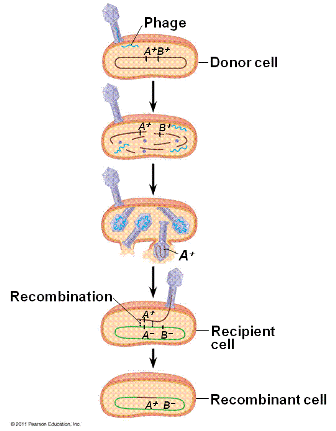 |
| Describe a typical bacterial chromosome. | One double-stranded circular DNA molecule associated with a small amount of protein (below is a diagram of bacterial chromosome replication) p559,  |
| The region of densely packed DNA in the ______ of a bacterium is called the ______. | cytosol, nucleoid p560 |
| A bacterial plasmid carrying genes that confer resistance to certain antibiotics. | R plasmid p564 |
| A DNA segment that confers the ability to form pili for conjugation and associated functions required for the transfer of DNA from donor to recipient. It may exist as a plasmid or be integrated into the bacterial chromosome. | F factor (below is a diagram of the F factor in plasmid form being incorporated into the bacterial chromosome, changing the cell from an F+ cell to an Hfr cell) p563,  |
| The plasmid form of the F factor is called the _____. | F plasmid (below is a diagram of the F factor in plasmid form being incorporated into the bacterial chromosome, changing the cell from an F+ cell to an Hfr cell) p563,  |
| In prokaryotes, the direct transfer of DNA between two cells that are temporarily joined is called _____. | conjugation (can happen in eukaryotic ciliates also in a sexual process in which the two cells exchange haploid micronuclei) p562,  |
| What is the result when an F+ bacterium conjugates with an F- bacterium? | both cells are F+ after the conjugation p563,  |
| What is the result when an Hfr bacterium conjugates with an F- bacterium? | The F- bacterium becomes a recombinant F- bacterium (it doesn't become F+ or Hfr because the F factor is usually broken off before it can completely enter the F- bacterium. However, the transfer usually drags some of the Hfr's other chromosomal DNA with it) p563,  |
The two bacteria in this photo have been caught in the act of ______. The long thing between them is a ______.,  | conjugation, pilus p562,  |
| What are three processes that bring together DNA from different bacteria? | transformation, transduction and conjugation p562 |
| A bacterial cell that has an F factor integrated into its chromosomal DNA is called a(n) ______ cell. | Hfr p563,  |
| A bacterial cell that has an F factor encorporated into a plasmid is called a(n) ______ cell. | F+ p563,  |
| Any organism that obtains energy from light is called a(n) _____. | phototroph p564 |
| Any organism that obtains energy from chemicals is called a(n) _____. | chemotroph p564 |
| Any organism that needs only carbon dioxide in some form as a carbon source is called a(n) ____. | autotroph (The carbon dioxide can be in the dissolved form of the bicarbonate ion, HCO3-) p564 |
| A catabolic pathway in which inorganic molecules other than oxygen accept electrons at the "downhill" end of the electron transport chain is called ____. | anaerobic respiration (Examples of alternate electron acceptors include the nitrate ion, NO3-, and the sulfate ion, SO4-2) G-2, p564 |
| A catabolic process that makes a limited amount of ATP from glucose, or other organic molecules, without an electron transport chain and that produces a characteristic end product, such as ethyl alcohol or lactic acid, is called ____. | fermentation (Anaerobic respiration is different from fermentation because it has an electron transport chain with something other than oxygen accepting the electrons. Since it has an electron transport chain, anaerobic respiration produces many more ATP than fermentation) G-14, p564 |
| Nitrogen is essential for the production of which two organic molecules? | amino acids and nucleic acids p564 |
Because the filamentous cyanobacterium called Anabaena can't carry out photosynthesis and nitrogen fixation in the same cell, it has specialized cells called _____ that only carry out nitrogen fixation, then share the synthesized nitrogen compounds with the rest of the cells in the filament, and in return, the photosynthetic cells share the carbohydrates they synthesize using photosynthesis.,  | heterocyst p565, 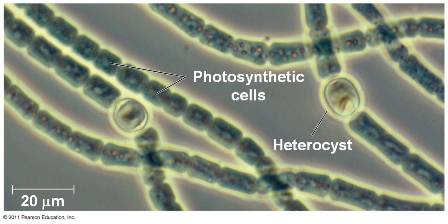 |
| Any organism that causes disease, including quite a few prokaryotic species, is called a(n) ____. | pathogen (Although pathogenic prokaryotes are the best known of the prokaryotes, they represent only a small fraction of prokaryotic species. There are no known pathogenic Archaeans. Bacteria cause about half of all known human diseases.) p570 |
| Where are two places that you would find bacteria that have symbiotic relationships with humans? | Skin and intestines (There may be up to 150 bacterial species with a density of 10 million cells per square centimeter. Our intestines are home to 500 - 1000 species of bacteria, most of them mutualistic that help us process our food. Because bacterial cells are so small, there are actually more bacterial cells in and on a human body than there are human cells) p571 |
| The disease caused by a bacterium that uses Deer Ticks as vectors for transmission to humans is called _____. | Lyme disease (If you see one of these ticks or the bull's-eye rash in the photo below, see your doctor right away. Try to save the tick and bring it to the doctor also.) p571, 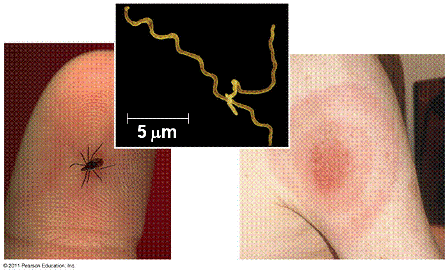 |
What are the hair-like structures labeled "A" in the picture below?,  | fimbriae p573,  |
What is "B" in the picture below?,  | cell wall p573,  |
What is "C" in the picture below?,  | Circular chromosome p573,  |
What is "D" in the picture below?,  | sex pilus p573,  |
What is "E" in the picture below?,  | flagella p573,  |
What is "F" in the picture below?,  | capsule p573,  |
| What type of organism is required to change milk into cheese or yogurt? | Bacteria p572 |